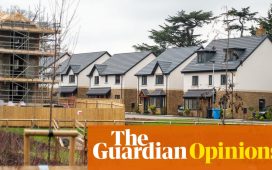Unlock the Editor’s Digest for free
Roula Khalaf, Editor of the FT, selects her favourite stories in this weekly newsletter.
Michael Gove on Tuesday insisted he had not “abandoned” housing targets following criticism over new planning policies that would give local authorities latitude to build fewer homes than official calculations suggest are needed.
In a speech, the housing secretary said the fresh approach would focus on ensuring local authorities have plans in place to guide development and put pressure on councils to swiftly process building applications.
Gove said housing targets based on calculations of local needs would “remain the basis” of the system but confirmed these would be “advisory”. He added the approach would be a “sensitive adjustment in meeting targets, not their abandonment”.
The government has been under pressure over its failure to reach its goal of building 300,000 new homes a year to tackle the UK’s acute housing shortage, but has been forced to compromise with Conservative MPs who have pressed for housing targets to be watered down.
Gove said opposition to development was “not unreasonable”. He added the policy needed to cater to concerns over the environment, services and the aesthetics of new structures to “[win] back support”.
Housing and property industry groups said the changes would mean fewer houses being built.
Ian Fletcher, policy director at the British Property Federation, said: “The government is watering down its own national targets and creating more obstacles and delays to housing delivery.”
Kate Henderson, chief executive of the National Housing Federation, which represents associations that provide affordable housing, said: “These changes, which effectively relax local housing targets, will result in fewer homes; and measures to get councils building and approving applications, whilst positive, won’t be enough to offset this risk.”
In an interview with The Times earlier on Tuesday, he said local authorities in England would have three months to put in place plans to meet their housing needs, with those that do not comply potentially losing their planning powers indefinitely to independent planning inspectors.
In his speech, he said councils would need to provide “rigorous evidence” to justify building fewer homes and that the government would publish “league tables” tracking the speed of planning approvals and delivery of targets.
Opposition leader Sir Keir Starmer has pledged to bring back the local targets, as he tries to position Labour as “the party of home ownership”.
The speech came as the government published long-awaited changes to the National Planning Policy Framework (NPPF), which sets out planning and land-use policies for England.
The changes confirmed concessions Gove made last year after pressure from backbench Tory MPs that the calculations of each area’s minimum housing needs would be an “advisory starting point”.
The revised NPPF also said councils will not have to review greenbelt boundaries or allow building that is “significantly out of character” with an existing area in order to meet housing needs.
Victoria Du Croz, partner at law firm Forsters, said: “This really is all about politics. He hasn’t addressed the fundamental concern that his reforms won’t deliver additional housing.”
Research commissioned by the Home Builders Federation (HBF), the trade body for housebuilders, found that the changes to the NPPF could mean 77,000 fewer homes built each year. Housebuilding numbers have already dropped sharply this year as high interest rates stalled the property market.
Stewart Baseley, executive chair of the HBF, said Tuesday’s announcement “does include some modest improvements to the planning process, [but] most are simply threats that will not make a difference in the short term”.










